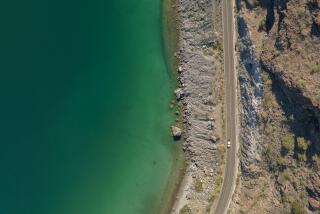Mountainous Road Opens ‘Shangri-La’ : Tourists Get Glimpse of Hunza Region Where People Live to 120
- Share via
High on the narrow, mountainous road known as the Karakoram Highway, or KKH, in northern Pakistan, rocks clang off the hood of my jeep, thump onto the back seat, ricochet from the windshield.
As my driver, Javed, swerves, a rock he has been watching that’s half the size of the jeep bounces onto the pavement inches from my knee.
We speedily round the mountainside onto a clear stretch of road. I look down over the edge of the highway, into the gray, churning waters of the Hunza River. A telephone wire runs parallel to the road, which runs parallel to the river--three lifelines moving in the same direction: toward Hunza.
About half the size of Massachusetts, with a population of 35,000, Hunza has long been one of the most remote regions of the Subcontinent, a realm jagged with glaciers and 20,000-foot-high peaks, connected to the outside world only by footpaths and a few barely serviceable tracks.
But in the mid-1960s the ruling mir, or chief, persuaded the Pakistani government to route the KKH through central Hunza. It took more than a decade to finish and cost 476 workers’ lives and uncalculated millions of dollars. In 1974 the mir stepped down, and Hunza came under the direct control of Pakistan; in 1978 the highway was completed. The combination of events transformed Hunza.
The Hunzakuts remain subsistence farmers, as they have been for more than a millennium. Every family owns at least one small plot of land, and the food they grow on their painfully cultivated plots is the food they eat; rarely has there been a surplus to sell or trade.
“Not a single tree, not a single plant has grown here by itself. Only it has been grown by man--all of these big trees, all of these small plants,” says Deedar Aly, a member of the Buroong clan of the Burusho, the dominant ethnic group of Hunza.
Aly shows me his family’s modest but flourishing orchard of apricot trees. Apricots have traditionally been an important crop. They are eaten fresh and dried, and the kernel is crushed to produce cooking oil. Every farmer has at least one tree.
“And no man in Hunza can sell his land to an outsider,” Aly says firmly. “For if a man were to sell his land, it would be like selling his children; it would be a shameful thing to do.”
Before the highway brought year-round supplies, by the end of one winter Aly’s family had only dandelion leaves, turnip tops and other weeds to eat.
When the British first explored this area at the end of the 19th Century, they were astonished to meet people who claimed to be more than 120 years old. These encounters inspired, some believe, the Shangri-La of James Hilton’s best-selling 1933 novel, “Lost Horizon.”
Hunzakuts don’t mind feeding the myth that they live longer than anybody else in the world, attributing it to their “pure” diet.
Until Pakistan assumed direct control of Hunza, the people of the region lived under the rule of the mirs, a single family of rulers who claimed to have reigned uninterrupted for more than 900 years.
“The mirs contributed to the rise of Hunza because they promoted contacts with the outside world,” explained Stephen Rasmussen, an American who is general manager of the regional Aga Khan Health Service. “And the Karakoram Highway is a perfect example of this.”
Ghazanfar Ali Khan would be the ruling mir if his family had not surrendered its power. “When my father, Mir Mohammed Jamal Khan, had the chance to bring the road through here, he did so because he saw that it would bring the people many good things,” he says. “Now, thanks to investments made by the Pakistani government, 80% of the people of Hunza have electricity, and almost all the households have water pipes with clean water coming through them. There are roads connecting almost all the villages with the KKH. There are five high schools in Hunza and two intermediate colleges.”
Most Hunzakuts agree that they have been more successful than other communities along the KKH because they are better educated. More than 90% of Hunzakut children today attend school.
Islam came to the area along the trade routes, and by the 1800s most of Hunza had converted. Today the overwhelming majority of Hunzakuts are members of a small sect of the Shiite community; its spiritual leader, the Aga Khan, is considered by his followers to be a descendant of the Prophet Mohammed through his cousin and son-in-law Hazrat Ali, and therefore an imam.
To many Westerners the Aga Khan’s name evokes the image of the present imam’s father, the playboy Prince Aly Khan, who married movie star Rita Hayworth.
Of all the changes the highway has wrought, the biggest, everyone agrees, is the widespread use of money. Before the KKH, the price of an ox was calculated in wheat. But now trading is on a big commercial scale and for money.
One of the biggest sources of cash income in Hunza today is tourism. Since the Khunjerab Pass opened, travelers have been coming to Hunza in increasing numbers; in 1991 nearly 40,000 foreign tourists passed through.
In the end, most Hunzakuts would probably agree with 80-year-old Subedar Mir Hazar, whom I find harvesting potatoes in his fields. As he works his hands in the soil, I ask him if the people of his generation regret the changes that the KKH has brought.
“Regret them?” he says. “Are you being funny? The road is the best thing that ever happened to us.”
More to Read
Sign up for The Wild
We’ll help you find the best places to hike, bike and run, as well as the perfect silent spots for meditation and yoga.
You may occasionally receive promotional content from the Los Angeles Times.






